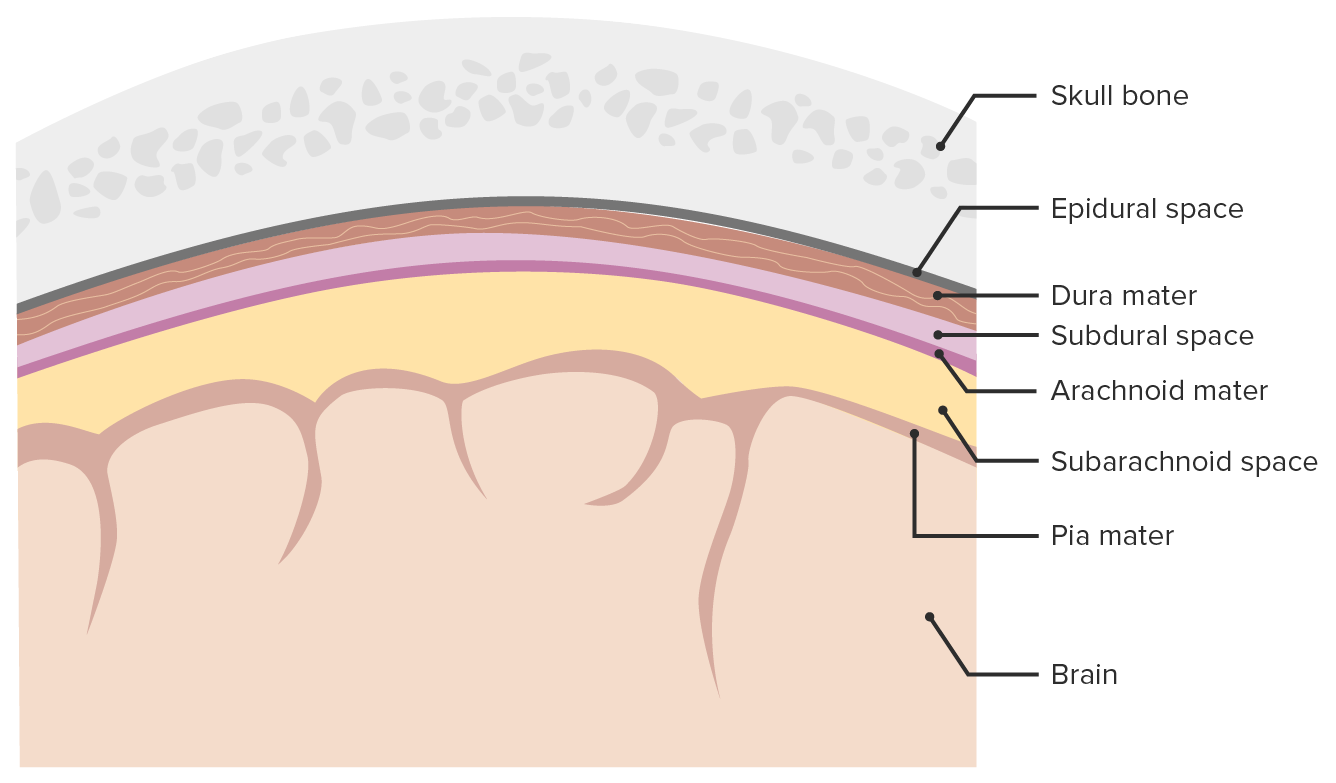Playlist
Show Playlist
Hide Playlist
Subarachnoid Hemorrhage – Intracranial Hemorrhage (ICH)
-
Slides 21 IntracranialHemorrhage HeadNeckAnatomy.pdf
-
Download Lecture Overview
00:00 The last space-occupying bleed or hemorrhage is known as the subarachnoid hemorrhage. 00:09 It’s important for us to understand the structural and clinical considerations of this form of bleed. This will be a bleed specifically into the subarachnoid space which is the area between the subarachnoid membrane and the pia mater. This is a normal space that contains the cerebrospinal fluid. The most common cause of a subarachnoid hemorrhage is going to be a cerebral aneurysm. However, head trauma or head injury can also result in a subarachnoid hemorrhage. In this illustration, we are showing the circle of Willis. We see a little dilatation right in through here within the circle of Willis. If we zoom in, we have this particular view and we see an artery at the circle of Willis. Here’s a branching point. An aneurysm within the circle of Willis can develop at branching points. If this aneurysm ruptures, that will result then in a subarachnoid hemorrhage. The vascular source of a subarachnoid hemorrhage with respect to an aneurysm rupture is within the circle of Willis. So, if there is a rupture of the aneurysm, where within the circle of Willis would you most commonly find a subarachnoid hemorrhage? The most common point at which a berry aneurysm will develop is at the branching point between the anterior cerebral and the anterior communicating arteries. That would be in the area that we see here. This is your anterior cerebral artery. It originates from the internal carotid shown here and then courses medially. We see its continuation at this point. 02:16 Then we see the opposite one over here, again coursing medially. Between the short distance between the right and the left anterior cerebral arteries, we have an anterior communicating artery. So right at that branching point and through here is going to be the most common location of a berry aneurysm that if it ruptures would be the source of the subarachnoid hemorrhage. Berry aneurysms can occur elsewhere where you have branching points, so along the course of the middle cerebral artery that we see here. You’ll have arteries that will branch off of it. At some of those branching points, you can have a berry aneurysm. Those tend to be more proximal. The third one to point out would be the branching point that exists between the internal carotid artery and the posterior communicating arteries. That would be shown in this location. Here’s your internal carotid. Here’s your posterior communicating artery. 03:22 So at this branching point, you could also have a berry aneurysm. So those are the three most common sites at which this can develop and again, the most common one is at the branching point between the anterior cerebral and your anterior communicating arteries.
About the Lecture
The lecture Subarachnoid Hemorrhage – Intracranial Hemorrhage (ICH) by Craig Canby, PhD is from the course Head and Neck Anatomy with Dr. Canby.
Included Quiz Questions
Subarachnoid hemorrhage causes bleeding to occur between 2 areas. Which areas are they?
- Arachnoid mater and pia mater
- Arachnoid mater and dura mater
- Skull and periosteal layer of dura mater
- Arachnoid mater and skull
- Dura mater and pia mater
What is the most common cause of non-traumatic subarachnoid hemorrhage?
- Aneurysm rupture
- Uncontrolled hypertension
- Hydrocephalus
- Pseudotumor cerebri
- Rupture of bridging veins
Which of the following is the most common site for berry aneurysm development?
- Branching point between anterior cerebral arteries and anterior communicating arteries
- Branching point between internal carotid artery and posterior communicating artery
- Branching point between superior cerebellar arteries and posterior cerebral arteries
- Branching point between anterior communicating arteries and posterior communicating arteries
- Branching point between posterior cerebral arteries and posterior communicating arteries
Customer reviews
5,0 of 5 stars
| 5 Stars |
|
1 |
| 4 Stars |
|
0 |
| 3 Stars |
|
0 |
| 2 Stars |
|
0 |
| 1 Star |
|
0 |
It is clear, well explained and very useful. Totally recommended.





